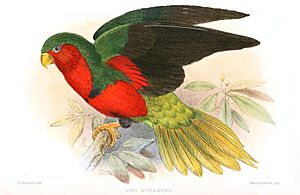Stephen's lorikeet facts for kids
Quick facts for kids Stephen's lorikeet |
|
|---|---|
 |
|
| Conservation status | |
| Scientific classification | |
| Genus: |
Vini
|
| Species: |
stepheni
|
The Stephen's lorikeet (Vini stepheni) is a small, colorful parrot. People also call it the Henderson lorikeet. It belongs to the parrot family, Psittaculidae. This special bird only lives on Henderson Island. This island is part of the Pitcairn Islands in the South Pacific Ocean.
Its natural home is in warm, wet lowland forests. The lorikeet faces dangers like losing its home. It is also threatened by new animals that might come to the island.
Contents
What Does the Stephen's Lorikeet Look Like?
These lorikeets are about 19 centimeters (7.5 inches) long. They usually weigh between 42 and 55 grams (1.5 to 1.9 ounces).
Adult birds have green feathers on their upper bodies. Their heads are also green. This green color turns yellowish-green near their tails. Their underwings are green. They have a green band across their chest. Their chest is red, turning purple towards their belly and legs. They have a bright orange beak and yellow or orange eyes.
Young Stephen's lorikeets have green undersides. They might have purple or red spots on their throats and bellies. Their tails are usually dark green. Young birds have brown beaks and brown eyes.
When these birds eat, they make soft, chirping sounds. Their calls are louder when they are flying.
How Stephen's Lorikeets Live
It can be hard to spot these lorikeets in thick trees. They often live in small groups or flocks. They are known to fly between the island's inner forests and the palm trees near the coast. They do this to find coconuts to eat.
What Do Stephen's Lorikeets Eat?
The lorikeets eat nectar from flowers. They also eat pollen, fruits, and the young forms (called larvae) of butterfly and moths. Most of the nectar they eat comes from the flowers of Scaevola sericea and Timonius polygamus plants.
Reproduction
Scientists believe their breeding season starts around April or early May. This is when they lay eggs and raise their young.
Threats to Stephen's Lorikeets
The Stephen's lorikeet is listed as a vulnerable species. This means it could become endangered if its situation does not improve. The IUCN keeps track of this. There are thought to be between 720 and 1,820 of these birds.
Because they live on only one island, they face big dangers. The main threats are new animals accidentally brought to Henderson Island. These animals could hunt the lorikeets. Another threat is losing their forest home. This can happen from cutting down trees or natural disasters. However, the lorikeets seem to have learned to live with the Polynesian rat. This rat is an invasive animal that was brought to the island. There was an attempt to remove these rats from Henderson Island, but it was not successful.
Where Stephen's Lorikeets Live
The Stephen's lorikeet is found only on Henderson Island. This island is part of the Pitcairn Islands. The birds live in coconut palm trees. They also live in the thick forests in the middle of the island.


